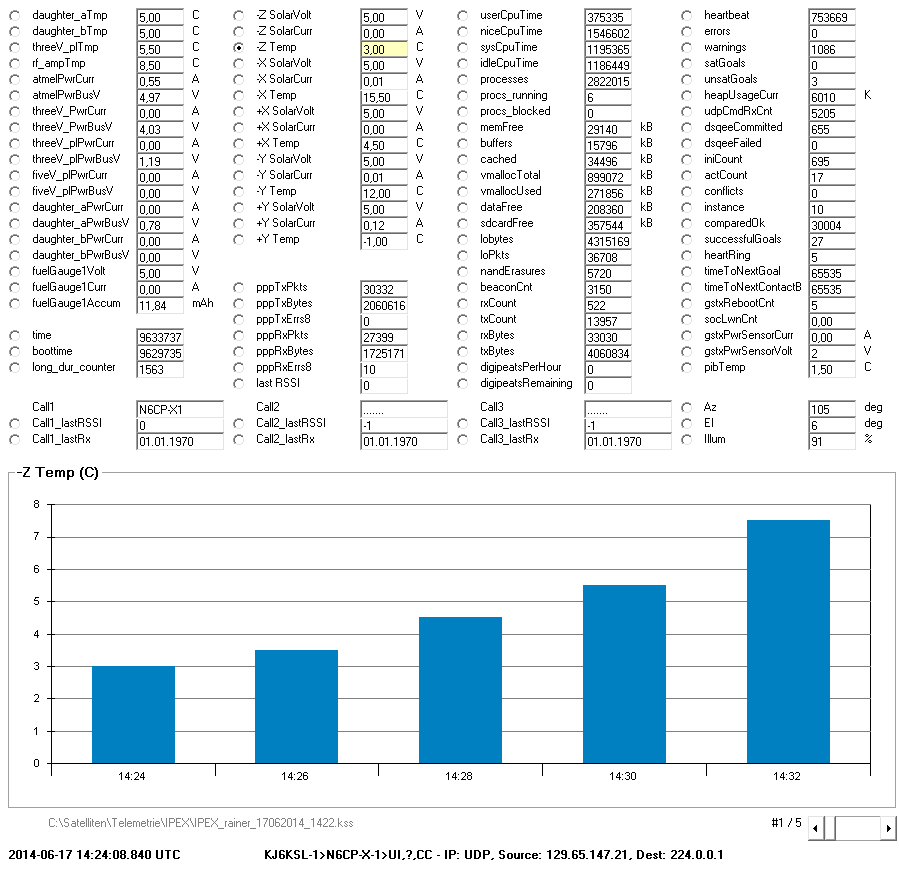
IPEX is a 1U (10 x 10 x 10 cm) cubesat, funded by NASA’s Earth Science Technology Office (ESTO), designed to validate onboard instrument processing and autonomous payload operations for the proposed NASA HYperSPectral Infra-Red Instrument (HyspIRI) mission.
IPEX carries several low-resolution (3 mega pixels) Omnivision OV3642 cameras as a stand in for actual science instruments on future NASA missions. These cameras are capable of acquiring many images (several per minute) over the mission lifetime providing data to validate onboard processing.
These images will be processed onboard using the Atmel™ primary flight processor as well as the Gumstix™ Earth Storm instrument processor in order to demonstrate near continuous onboard instrument processing. The Continuous Activity Scheduler, Planner Execution and Replanner (CASPER), Specialized onboard planning software developed by the Jet Propulsion Laboratory, California Institute of Technology, will control the image acquisition and image processing and run on the Atmel processor.
NASA-Catalog: 90704
Downlink
437.270 MHz FM 9k6 FSK AX.25
Call
KJ6KSL
Status
INACTIVE
Orbital Parameter
NORAD 39471 COSPAR designator 2013-072-K Inclination 120.496 RA of A. Node 74.497 Eccentricity 0.0284692 Argument of Perigee 240.559 Revs per day 14.67856402 Period 1h 38m 06s (98.10 min) Semi-major axis 7 046 km Perigee x Apogee 467 x 869 km BStar (drag term) 0.000287490 1/ER Mean anomaly 116.673
The IPEX spacecraft and core flight software is developed by California Polytechnic University at San Luis Obispo. The IPEX spacecraft has solar panels on all six sides for power generation, three battery packs for power storage, and a custom designed deployable antenna for communications. Primary communications will be over the UHF band; the satellite will automatically beacon satellite health data which will be decodable by the amateur community. After the mission lifespan, the satellite will be put into digipeter mode for use by amateur operators. The primary flight computer is a 400MHz Atmel AT91SAM9:ARM9™ with the processor card carrying 128 MB RAM and a 16GB SD card for data storage. The payload processor is a Gumstix Earth Storm with 512MB RAM and 512MB flash as well as second 16GB SD card. The principal elements of the IPEX hardware and flight software have been tested with two balloon flights 28 July 2012 and 09 December 2012 with approximately four hours flight time and reaching over 100,000 feet above sea level. IPEX was launched into Low Earth Orbit on an Atlas V rocket from Vandenberg Air Force Base in December 5th 2013. After attaining orbit, the IPEX spacecraft self stabilized using passive magnets mounted in the IPEX structure. After stabilization, IPEX is commanded from the earth station at Cal Poly San Luis Obispo. During the IPEX flight, imaging and image processing requests will be processed automatically by earth automation software that will develope observation, processing, and downlink plans from requests and an encoded operations models without need for human intervention. This automated, web-based operations is a key part of the IPEX mission.
Telemetry
from KJ6KSL-1 to N6CP-X-1: 1 > 45 00 00 A8 00 00 40 00 01 11 84 ED 81 41 93 15 E0 00 00 01 21 > C3 54 00 03 00 94 22 72 28 00 00 00 00 00 00 10 91 00 07 BE 41 > D0 62 DD E1 A4 66 F0 28 C4 7F 6F DC C4 53 FF 3C 2F 85 E5 B3 61 > D0 B3 22 1B 0B 11 59 71 7F 45 3F 88 D6 3F BD 73 AB E6 8C A4 81 > B5 46 C6 EB E1 55 4A 9F 75 75 C1 EF C3 C3 BF 05 8B 40 B5 A4 101 > 63 80 3F 39 2E 36 34 96 AE 8F D5 BB 56 0C 0C DC 62 54 55 C8 121 > 1A 23 27 C1 95 FA F3 E9 99 4E 49 65 99 05 F5 B2 FA B8 96 8A 141 > C2 46 12 90 7E FA 7B 1D B3 AA 3F 04 B4 8A 96 55 5E 80 1D DF 161 > 6B BE 74 42 0F EB A2 4C
08.12.2013 01:50 UTC – telemetry (DK3WN)
